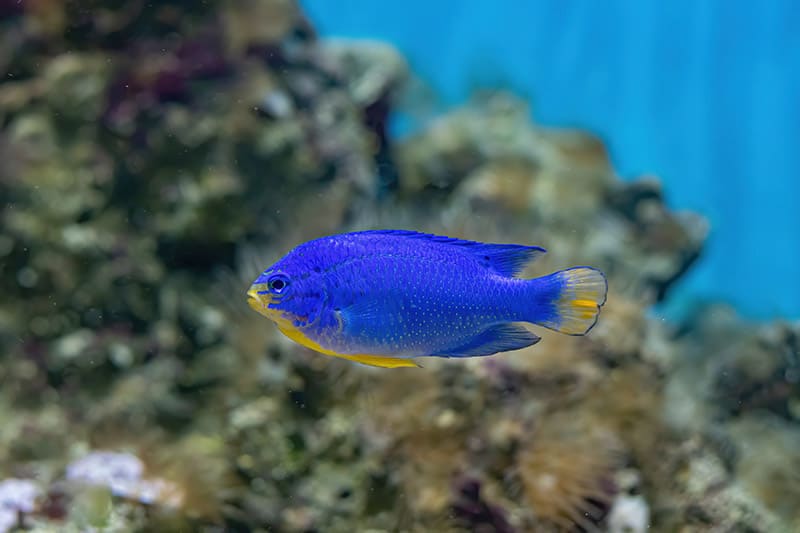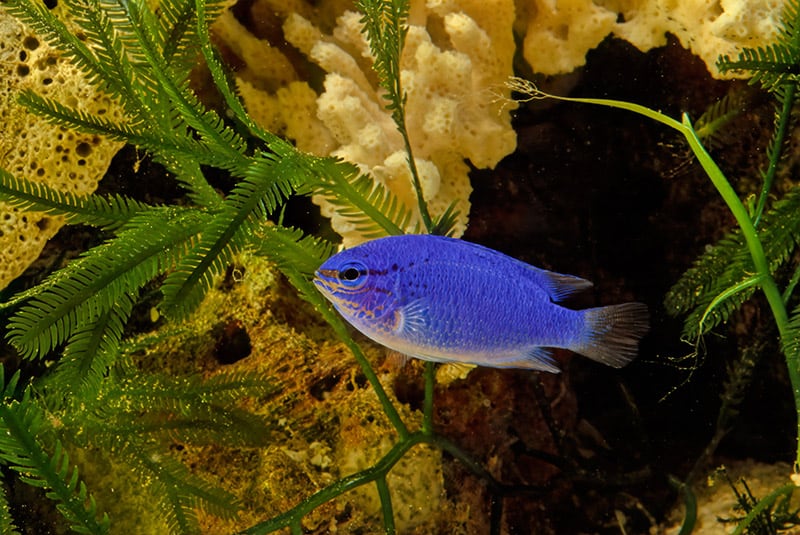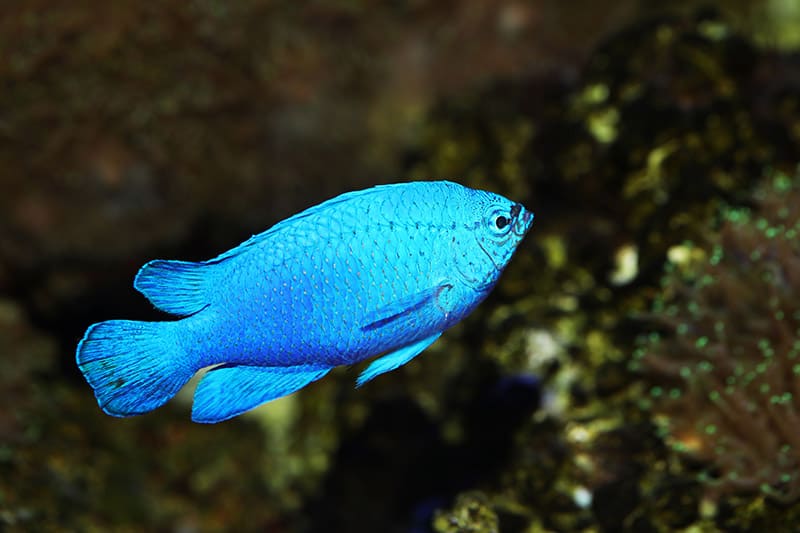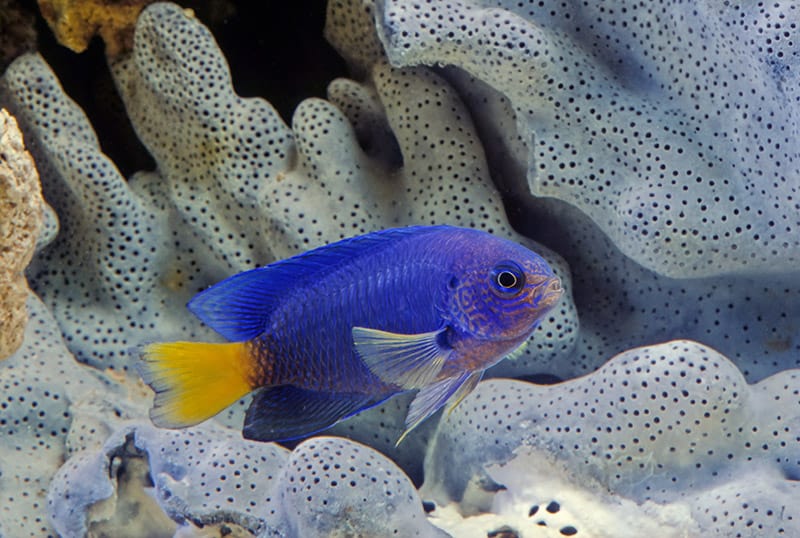Damselfishes (Family Pomacentridae) are well-known even to laymen worldwide and the species list still is growing.
Damselfishes (Family Pomacentridae) are well-known even to laymen worldwide and the species list still is growing. 320 species were recognized (Allen, 1991), but every year some new species have been added to the list, and now the valid species would reach 370 in number, including undescribed ones (John Randall, pers. comm., 2005). Also several changes of scientific names among the known species were done since the Allen’ work; some have been treated as junior synonyms (as being same with other valid ones, and have naturally been deleted from the valid species list) and some member have been separated into more than two distinct species. There are so many damselfish having a blue body and some still are misidentified in recent popular literatures, but the Blue Devil is quite distinctly colored with metallic blue to blackish blue depending on the strength of light, and I can even express that it is an almost bright blue-green fish especially under the sun.

Another popular blue fish of Pomacentridae, called the Blue Damselfish (Pomacentruscoelestis) is often confused with the Blue Devil but the former has no black line through the eye. In Okinawa I could see them in small, shallow tidal pools by the sea at the depth of as shallow as 20 cm, and they were the brightest fish in the wild. I did not see larger individuals but smaller ones less than 4 cm long can be found everywhere in tidal pools. I saw a small group comprising several male specimens of approximately 6 cm at a harbor in Okinawa in 2005, and they were swimming near the surface; the species loves shallower waters of 0-10 meters (Fig. 4). Divers who will dive deep from a boat offshore can never encounter the species.
This species is known to have several color morphs; some have an orange tail, some possess a yellow one, and some with a yellow chest, too. Female of the Blue Devil are entirely blue without any yellow or orange coloration, but some females from certain localities have a black ocellus on lower posterior part of the dorsal fin. Also they have nearly translucent fins (Figs. 1&2), versus totally blue fins in males. It means that this species has a sexual difference. Juveniles are also entirely blue with translucent fins that are similar to females. When they get a size of males they will acquire a yellow-orange coloration in body and fins.

I saw a male in the Waikiki Aquarium of Oahu some 15 years ago, and it had a yellow abdomen, yellow ventral fins and an orange caudal fin, being a quite impressive fish in the display tank. This color form comes only from Palau and Yap of Micronesia, and the coloration of orange covers the entire caudal fin and much of the peduncle, but some males have a white area at the caudal peduncle (Fig. 5). The chest and abdomen are also orange-yellow, and those from Palau and Yap is the most attractive. The species has not been reported from any other locality in Micronesia.
I purchased ten males at he same time at a retailer in Tokyo (Fig. 6) but they aggressively fought and only a single male survived in the aquarium. The ‘king’ of victory finally let a single female spawn in the aquarium and he exhibited darker areas on body (Fig. 7) when it attracted the female (= displaying color). The female repeatedly spawned and approximately hundred eggs were seen in the inside of a non-living giant clam after every spawning behavior, but I could not see any hatchery.

Chrysiptera cyanea widely ranges in the Western Pacific, from southern Japan (Wakayama Prefecture, southern Honshu, but extremely rare), and common in the Ryukyu Islands, Taiwan, the Philippines, Indonesia, the Great Barrier Reef, Papua New Guinea, the Solomon Islands, New Caledonia to Vanuatu, and in the Indian Ocean it occurs in the Rowley Shoals (off Western Australia).
In Indonesia, the males have a yellow caudal fin, yellow pelvic fins and a yellow chest and abdomen, that are similar to those from Palau, but the yellow area covers the caudal fin partially, and the peduncle is blue (Figs. 8 & 9). Also they possess a black spot on posterior part of the dorsal fin that is lacking in Micronesian males. According to Rudie Kuiter (pers. comm.) the males from the southern coasts of Flores Island, Indonesia have a yellow coloration on body and fins (like Sulawesi males) but in the northern coasts they are entirely blue.

In the Great Barrier Reef of Australia and Papua New Guinea regions the male has a yellow posterior part of the caudal fin only, and no yellow area can be seen in any other part of body or fins (Fig. 10). The species is commonly encountered in the northern part of the Great Barrier Reef but it becomes scarce in the southern part. It co-occurs with the closely related C. taupou (popularly called the South Seas Devil, or the Fiji Devil~ Fig. 3) in the limited northern part but it is far less than C. cyanea there, and is very common in Coral Sea where C. cyanea is absent except a few localities).
In the Rowley Shoals (off Western Australia, the Indian Ocean) C. cyanea was recently recorded by a diver Rudie H. Kuiter of Australia and the coloration of males is quite unusual, in having orange-yellow only in pelvic fins (Fig. 11). A Black spot can be seen on the lower side of the posterior part of the dorsal fin that is also seen in Indonesian male forms.

According to Allen (1975, 1991) C. cyanea distributes also in the Mariana Islands and the Caroline Islands but it was an error (G. Allen, pers. comm.). I have never seen specimens from Vanuatu or New Caledonia where another morph would be expected.
The Blue Devil is a very hardy fish that can be kept with larger angelfishes, butterflyfishes, wrasses, and even smaller groupers. Also it can be housed in a reef set without any trouble on live inverts except some small shrimps that might be attacked by the devil. If you keep them of a number of specimens provide the tank with many crevices where some of them can dart into. Remember, they are aggressive toward each other and fight and lead weaker individuals to a destructive result. If kept in a good condition you could see their reproductive behavior and eventually so many tiny eggs can be seen in your home. Put them in a tank with a stronger light, if possible under a sunshine, and you should be able to see them in a dazzling, brilliant hue like that of a precious jewel.
Featured Image Credit: Podolnaya Elena, Shutterstock
